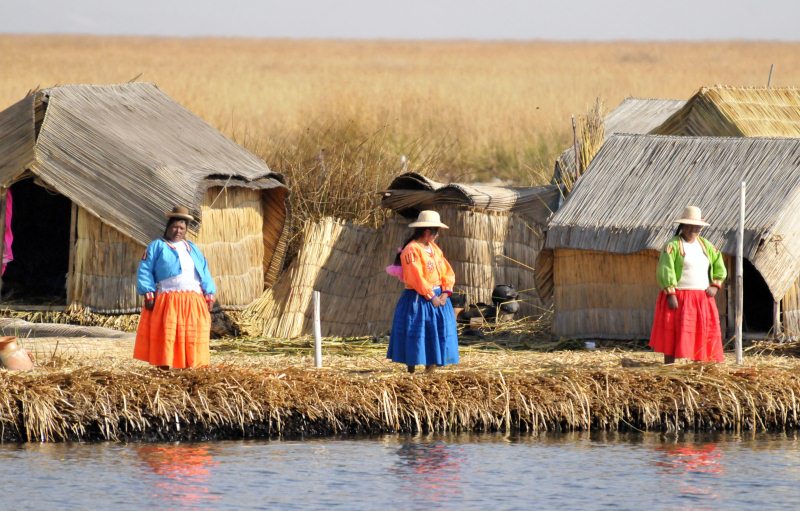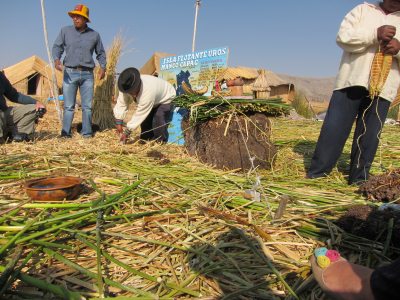Uros

|
Uros

We left the quayside and made our way through the reed bordered waterway to our first visit to a floating island of Uros. Uros are a pre-Incan people that live on forty-two self-fashioned floating islands on Lake Titicaca, Peru and Bolivia. They form three main groups: Uru-Chipayas, Uru-Muratos and the Uru-Iruitos. The latter are still located on the Bolivian side of Lake Titicaca and Desaguadero River. The Uros use bundles of dried totora reeds to make just about everything they need and the islands themselves. The Uros islands at 3810 meters above sea level, are just a mile west from Puno port. Around two thousand descendants of the Uros were counted in the 1997 census, although only a few hundred still live on and maintain the islands; most have moved to the mainland. The Uros also bury their dead on the mainland in special cemeteries. The Uros do not reject modern technology: some boats have motors, some houses have solar panels to run appliances such as televisions and the main island is home to an Uros-run FM radio station, which plays music for several hours a day. Early schooling is done on several islands, including a traditional school and a school run by a Christian church. Older children and university students attend school on the mainland, often in nearby Puno.
 History: The Uros descend from a millennial town that according to legends are "pukinas" who speak Uro or Pukina and believe they are the owners of the lake. Uros used to say that they have black blood because they did not feel the cold. Also they call themselves "Lupihaques" (Sons of The Sun). Nowadays, Uros do not speak the Uro language, nor practice their old beliefs but maintain some old customs. The purpose of the island settlements was originally defensive, and if a threat arose they could be moved. The largest island retains a watchtower almost entirely constructed of reeds. The Uros traded with the Aymara tribe on the mainland, interbreeding with them and eventually abandoning the Uro language for that of the Aymara, losing their original language about five hundred years ago. When conquered by the Inca empire, they had to pay taxes and often were made slaves. We had a welcoming committee and the island 'president' - Marcos was their to shake our hands. Manuel our guide then settled us on a reed bench to learn of their lives.
  Traditional lifestyle: The larger islands house about ten families, while smaller ones, only about ninety feet wide, like this one, house only two or three. The islets are made of totora reeds, about six feet deep, sitting on the roots that are about three feet thick called Khili that support the islands. They are anchored with ropes attached to sticks driven into the bottom of the lake. The reeds at the bottoms of the islands rot away fairly quickly, so new reeds are added to the top constantly, if you think it would be smelly - not at all, just a little like fresh cut celery. In the rainy season when the reeds rot much faster they have to replace quicker. The islands last about thirty years before the locals have to start from scratch. Each step on an island sinks about two to four inches depending on the density of the 'ground' underfoot, if a bigger scoots past the whole island can be seen to rise and fall like a lilo on a swimming pool in a gentle swell. As the reeds dry, they become brittle, as the reed breaks up and moisture gets in, it rots, and a new layer has to be added, a constant cycle, hard work that the whole family joins in to maintain. The people here put on a good face for tourists but we spoke to an American couple who had stayed the night with a family who really did not like the intrusion, they had to embrace the couple due to the communal rules. We were glad we were just day visitors, tourism however does provide financial opportunities for the natives, while simultaneously challenging their traditional lifestyle. We felt very welcomed and whilst the ladies were cooking the young ones took us to a hut, Bear was hatted and waistcoated.
  Much of the Uros' diet and medicine revolves around totora, when a reed is pulled, the white bottom is eaten for its iodine content, preventing goitre they tell us. This white part of the reed is called the chullo (Aymara) we thought it tasted like soft asparagus, juicy but very dull after a while, though. Like the Andean people of Peru rely on the Coca Leaf for relief from a harsh climate and hunger, the Uros rely on the Totora reeds in the same way. When in pain, the reed is applied to 'absorb' it. If it is hot outside, they roll the white part of the reed in their hands, split it open, place it on their forehead as a coolant, very refreshing just like a wet wipe. The white part of the reed is also used to help ease hangovers. It is their primary source of food and also their tea - reed flower tea.
  Local residents fish ispi, carachi and catfish. Trout was introduced to the lake from Canada in 1940 and kingfish were introduced from Argentina. Uros also hunt birds such as seagulls, ducks and flamingos and graze their cattle on the islets. They also run crafts stalls aimed at the numerous tourists who land on ten of the islands each day. They barter totora reeds on the mainland in Puno to get products they need, such as quinoa and other foods. Food is cooked with fires placed on piles of stones. To relieve themselves, tiny 'outhouse' islands are near the main islands. The ground root absorbs the waste.

ALL IN ALL NOTHING COULD HAVE PREPARED US FOR WHAT WE SAW |